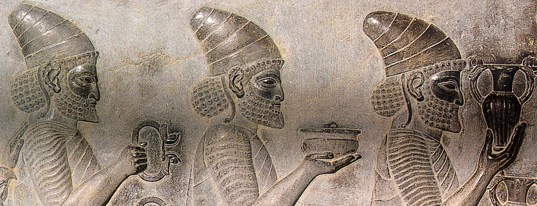Authors

Guidelines for Authors
All entries for the Encyclopædia Iranica (EIr) are commissioned by invitation only, and each received entry is subject to peer review. The language of the EIr is English, and all submissions must follow the EIr’s in-house style in order to be accepted for review.
Font. The entry should be written using a Unicode font. To minimize editing and production glitches, we urge use of the free Charis SIL Unicode font available for download on the internet at http://software.sil.org/charis/download/.
Spelling and punctuation. The EIr uses American spelling and punctuation. Foreign words may be anglicized in accordance with Webster’s Third International Dictionary. Well-known toponyms, including place names in Iran, Afghanistan, the Middle East, Central Asia, and the Indian Subcontinent, follow spellings in Webster’s Geographical Dictionary or are transliterated. Place names not normally written in Persian script should follow the approved form given on the NGA Geonames Search site. The EIr in-house editorial style uses the serial comma among other conventions; as a general guide to punctuation and related matters refer to the most recent edition of the Chicago Manual of Style.
Transliteration. The EIr uses its own transliteration system for Persian and Arabic. Click here for the details. But other transliteration systems (e.g., Library of Congress, Encyclopaedia of Islam, or IJMES) are fully preserved in cited references.
Dates. Whenever appropriate, dates are given only as Common Era (CE) dates: 2nd millennium BCE, 445-440 BCE, 7th century CE, the 1850s, 19 August 1953. Whenever a reference to other calendars is necessary, for example for dated documents or artifacts, the CE date follows the original date: For example, Islamic lunar calendar dates are given in the format 886/1481-82 or 20 Jomādā I 857/29 May 1453. The use of Šamsi dates is discouraged except when absolutely necessary, in which case the era should be noted with the abbreviation “Š.” Dates using other eras should also be indicated clearly.
Entry format. Every EIr entry comprises a definition, a text, a bibliography, and illustrations, if needed.
The definition (not given in the form of a complete sentence) conveys the entry’s significance and range:
ĀBĀDĀN, name of an island and a city at the head of the Persian Gulf, within the province (ostān) of Khuzestan.
AVICENNA, philosopher and physician (980-1037).
MOṬʿA, legal contract for a temporary marriage.
SHAPUR II, Sasanian king (309-79).
Whenever a technical term, such as an official title, such as moḥaddeṯ (transmitter of hadith), or a religious concept, such as maktab-e ešrāq (school of Illuminationist philosophy), is mentioned for the first time, it must be followed by a gloss in parentheses.
An EIr entry has no footnotes. References to sources and studies are abbreviated in the text to the greatest extent possible as full bibliographical information is provided in the bibliography.
The titles in the bibliography are cited under the names of their author. If the bibliography contains more than one work by the same author, the year of publication is added to the author’s name in the text. Please note that the EIr keeps a list of abbreviations here: Abbreviations of Journals.
The following examples illustrate how titles are listed in a bibliography:
E. G. Browne, A Year amongst the Persians: Impressions as to the Life, Character, and Thought of the People of Persia Received during Twelve Months’ Residence in that Country in the Years 1887-1888, 1st ed., Cambridge, 1893.
W. B. Henning, “A List of Middle-Persian Parthian Words,” BSOS 9, 1937, pp. 79-92.
Idem, “The Date of Sogdian Ancient Letters,” BSOAS 12, 1948, pp. 601-15.
W. Madelung, Religious Trends in Early Islamic Iran, New York, 1988.
Mirzā Maḵdum Šarifi Širāzi, al-Nawāqeḍ le-bonyān al-rawāfeḍ, British Library, London, MS or. 7991.
This list shows how these titles would be cited in the text:
(Browne, pp. 37-39; Henning, 1948, p. 608; Henning, 1937, pp. 85-87; Madelung, pp. 76-79; Šarifi Širāzi, fols. 5b-6a)
In longer bibliographies, the listed titles may be divided into Sources and Studies. Comments may be added in parentheses at the end of the bibliographical data for an item.
Sources:
Farid-al-Din ʿAṭṭār, Manṭeq al-ṭayr, ed. M. R. Šafiʿi Kadkani, Tehran, 2004.
K. Ṭāherzāda Behzād, Qiām-e Āḏarbāyjān dar enqelāb-e mašruṭiyat, Tehran, 1955, pp. 467-509 (Amirḵizi’s autobiography).
M. Boyce, A Reader in Manichaean Middle Persian and Parthian, Acta Iranica 9, Leiden, 1975.
Mottaḥed al-maʾāl, 3 Dey 1306 Š./24 December 1927; Sāzmān-e asnād-e melli-e Irān, Tehran, document no. 390006404.
Qabāla-ye kār-gozāri-e Eṣfahān, n.d.; Sāzmān-e asnād-e melli-e Irān, Tehran, document no. 291003576.
Studies:
C. A. Burney, “Excavations at Yanik Tepe,” Iraq 23, 1961, pp. 138-53.
Idem, “Excavations at Haftavan Tepe, 1973: Fourth Preliminary Report,” Iran 13, 1975, pp. 149-64.
J. R. Crumb, Review of Malay Literature by G. Finchley, Critical Studies 18, 1974, pp. 313-15.
K. Kreiser, “Evliya Çelebi,” ottomanhistorians.uchicago.edu, C. Kafadar, H. Karateke, and C. Fleischer, eds. (accessed on 08 December 2015).
F. S. Kuznetsov, “Kochevniki Irana” (Nomads of Iran), Ph.D. diss., Moscow State University, 1999.
A. Levshin, Opisanie Kirgiz-Kazachikh, ili, Kirgiz-Kaisatskikh ord i stepeǐ, St. Petersburg, 1832; tr. F. de Pigny as Description des hordes et des steppes des Kirghiz- Kazaks, Paris, 1840.
M. Pehlivanian, “Mesrop’s Heirs: The Early Armenian Book Printers,” in E. Hanebutt-Benz et al., eds, Middle-Eastern Languages and the Print Revolution: A Cross-Cultural Encounter, Westhofen, 2002, pp. 53-92.
E. D. Ross and J. Gurney, “Browne, Edward Granville,” Oxford Dictionary of National Biography, Oxford University Press, 2004, doi:10.1093/ref:odnb/32120.
Illustrations. Each plate, figure, map, or table must be accompanied by a detailed caption. Photographs should be submitted as high-quality digital scans. The author is responsible for obtaining the permission to publish any copyrighted material. Please note that the EIr keeps an continually updated list of digital resources here: Resources. Authors are encouraged to consult these resources for possible illustrations, since many of the listed databases make their digital surrogates available at no cost to academic non-profit projects such as the EIr.
Revised November 2020

